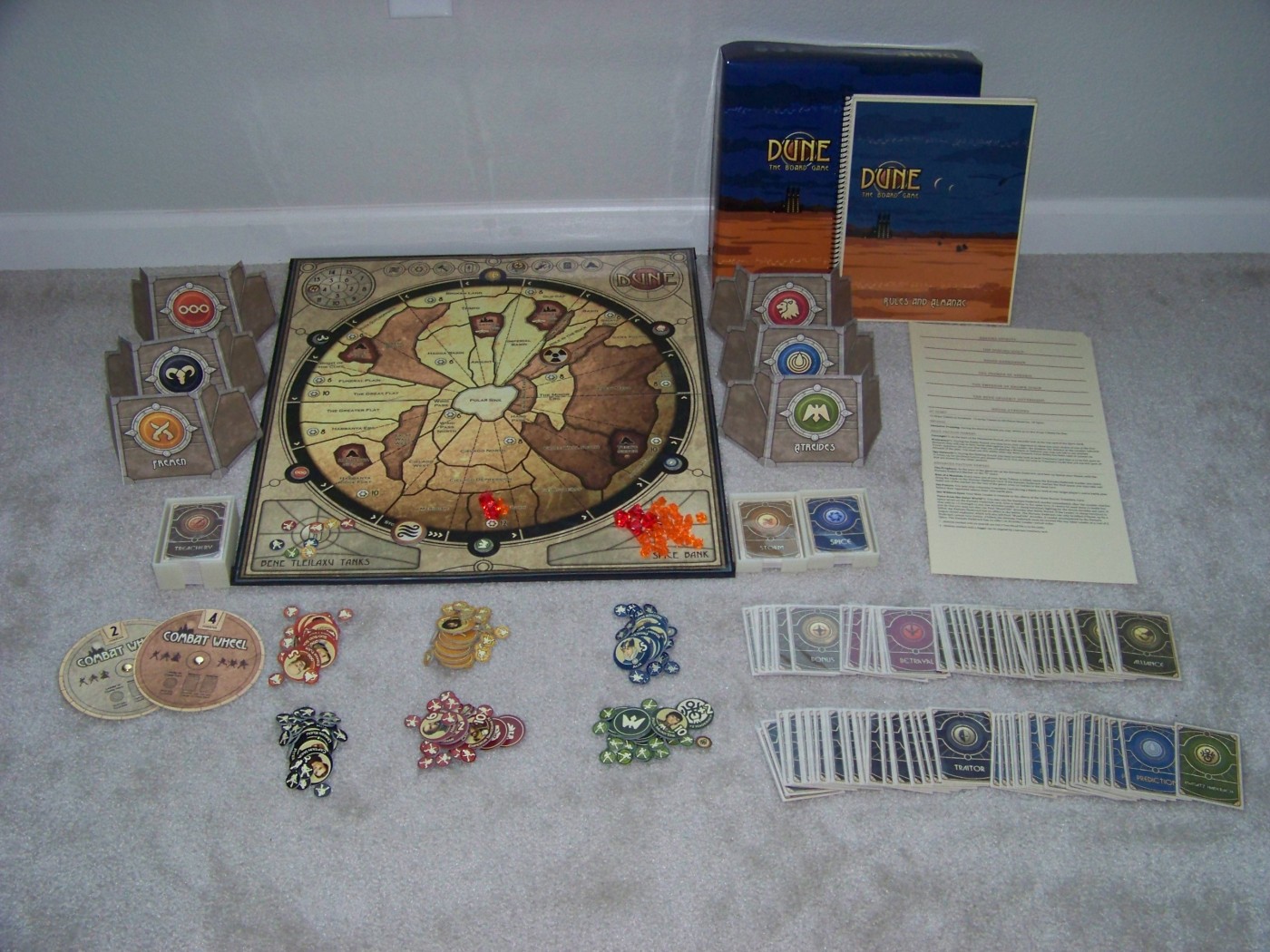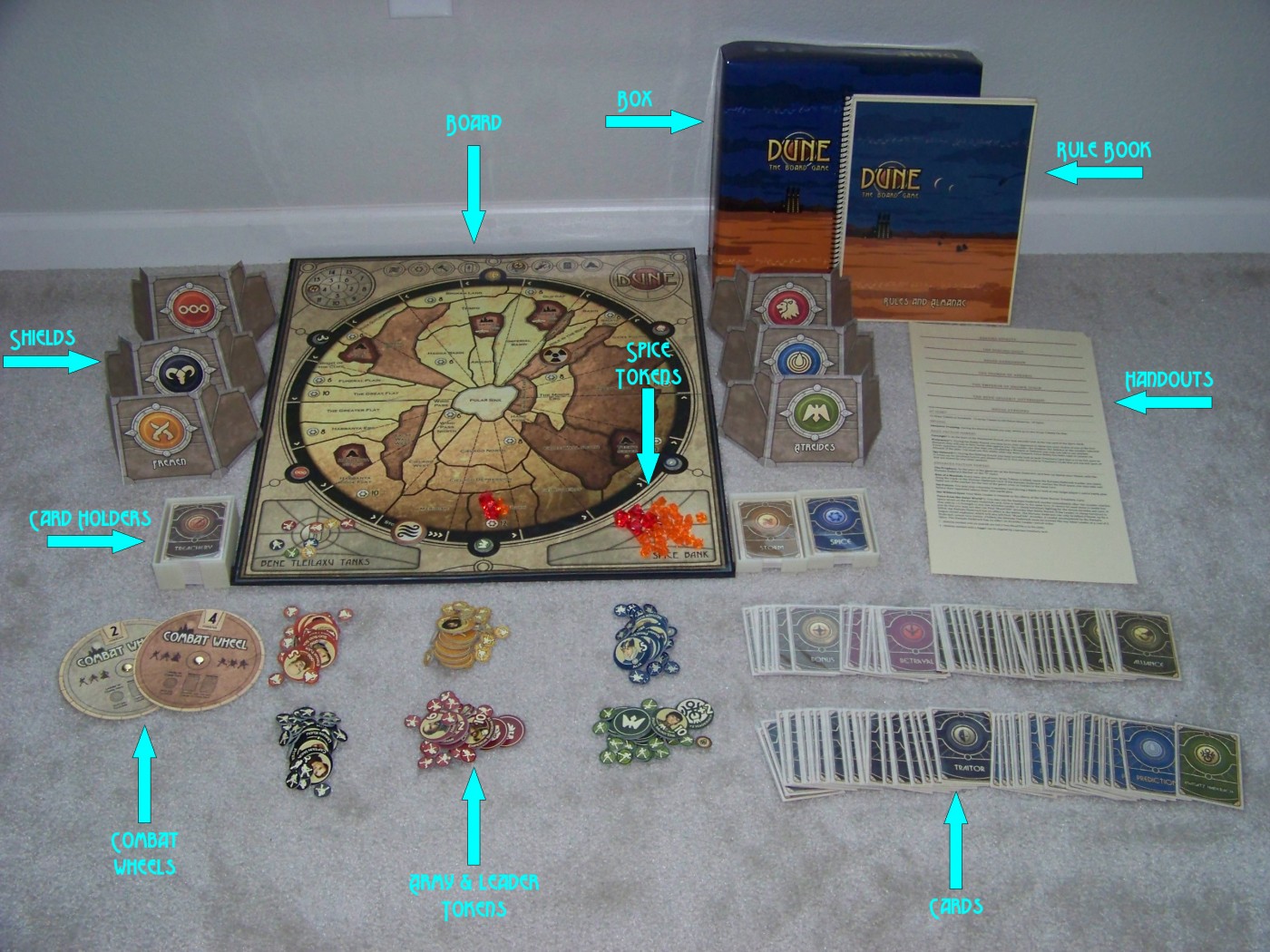Over the last couple of months, I have been working on a print-and-play copy of the 1979 Avalon Hill Dune Board Game. I finished it up last week, and promptly sent it off to my best and oldest friend John for his birthday. However, I did get a few pictures (and, of course, I still have all of the printables), and I wanted to take the time to talk a bit about all the things that went into this build, especially as it is my first complete print-and-play board game.
The Picture
First, here is a picture of the completed product, all laid out (and one with annotations):
The Box
I’ll start with the box, at the top right of the image. This part of the build was fairly simple, as it was a reclaimed Descent: Journeys in the Dark expansion box, recovered with new art. For the top of the box, I resized/cropped the art directly from Ilya’s Dune redesign, and had it printed and laminated at Staples on their poster printer. For the bottom, I used black art paper, which I picked up from Hobby Lobby.
The main thing I like about this setup is that it’s fairly straight-forward. Once the art is printed, I just needed to cut the pieces and glue it to to the box. For the bottom half, this is even easier, as there is no art to print, just cut the art paper to the right size and glue it on. However, this is the second box I’ve made, and I still thing there is room for improvement on the technique. In particular, folding laminated heavy paper is a pain, and (if you look close, you can see this in the image), it tends to curl a bit, and doesn’t stick well. I’m not sure what I might do about this in the future – One thought was to score the laminate on the edges to force it to fold, but I worry that will weaken the box where I need it most. I will probably be scouring the internet on this one, and am very much open to suggestions.
The Rule Book and Handouts
The Rule Book originated from Slev’s Dune 2010 Rules Rewrite, where I read through and tightened up various bits that caught my eye. I also laid out the entire thing with a more earth-toned style, and eye toward sticking in some art where I could. Then, I printed the whole thing out on my home printer (double-sided) on some snazzy specialty paper from Staples. Finally, I printed the covers on cream-colored heavy card stock, and dropped it off to Staples for laminating the covers and spiral binding. The handouts are simply the faction pages, and Karama card descriptions from the main rule book, printed off on the cream colored card stock.
I’ll fully admit that Slev did the main part of the work here, obtaining and organizing all the rules into a coherent whole, while the layout was a lot of fussing over font sizes and making sure that things that I wanted to fit on a single page did so reasonably. I spent a bit more time on the “Basic Rules” section to make sure that the rule book had room for various pieces of art where there were partial pages, and pictures of all of the components where needed. For the rest of the book, I didn’t try to get any art assets, primarily because many of the assets didn’t exist in Ilya’s redesign, and there was less room with all the text. It’s certainly something I’ll go back to eventually, however.
The main disappointment for me on this part of the project was how the covers fit onto the rule book. Unfortunately, when Staples did the binding, they left a huge amount of laminate on the edges of the covers, then put the binding on so that everything aligned to the bottom (rather than center). This made the book feel very off center. When I got it home, I removed the spiral and used my paper-cutter to remove as much excess laminate as I could, and realigned the cover. The only part that didn’t quite work out was that spiral holes were in the laminate, rather that in the paper itself, so that left the covers sticking out considerably, but I was able to get them to at least center. For me, this was a lesson-learned: Laminating leaves a lot around the edges, if you want that removed before binding, ask for it.
Tokens
The Spice Tokens were the only part of this set that I didn’t build myself, and, I’m glad I didn’t because these, I feel, really give the game a bit of, well, spice. I picked them up from WholeSalers USA, and, I have to admit, these look pretty nice in person.
The most exciting part of this build for me though, was the fact that the army and leader tokens turned out well. I’ve struggled with tokens for a number of my prior builds because I’ve wasn’t able to find a combination of printable material and stock that is easy to put together and still looks good. With this build, I used full-sheet shipping labels for the printing material and I utilized my Solidoodle3 3D printer to print out ABS plastic discs to stick them to. I played around with a lot of different sizes before I decided that discs that were exactly the same size as the punched out tokens gave the best combination of look and feel. The only worry I have is for the longevity of the tokens – because the discs were the exact same size, I expect that the shipping labels will be liable to peel off after a lot of use; I’ll be checking back with John to see.
Cards and Card Holders
Cards are something I feel like I’ve gotten pretty good at, and my process worked perfectly this time around. Dune has a lot of cards, and I was easily able to whip out all of them in a weekend.
While Ilya’s redesign was beautiful from an art perspective, I found that I had to rework almost every card with updated text to match the rule book (or, in a number of cases, make it concise enough to fit). While I’ve used Strange Eons in the past to do this task, this time I just used Adobe Fireworks – this came with a few frustrations (most notably, memory problems), though I avoided having to write a custom one-use plugin for the cards, which probably saved me more time in the long run. Ilya also made all of the source material available, which not only made this possible, it also allowed me to create other cards that were missing from his set, and create a couple popular options (like the Prediction and Betrayal decks).
The Card Holders, like the tokens, I also printed out on my 3D printer, and were my own design from the ground up. I used Mayday Games card sleeves to sleeve all the cards in the game, and then used their sleeve chart to create a design that had enough wiggle room to allow the cards to sit comfortably, but still easy to pull out during play (or just to hold cards in the box). The upshot to this design work was that when I was done, I had enough card holders to corner the box, and lift the board above all the rest of the pieces – everything fit perfectly!
Combat Wheels and Shields
The Combat Wheels I printed directly off from Ilya’s design, and attached together with a brad – piece of cake! The Shields took only a little more work; once I had edited the faction rules down (getting them to fit on the shield and be rotated correctly was a bit of a chore), I used a technique similar to how I made cards applied to the larger pieces. The main thing here was that since the shields had to fold, just gluing two pieces of card stock together would not work as well. So, I cut the outside of the shield (the side with the house name and logo) along the folds, so that only one piece of card stock would actually fold (the inside), while the outside would “break apart” as needed. This seemed to work pretty well on my test trials, but, again, I’ll have to talk to John to find out how well it works in the long run and holds together.
The Board
The Board was the other main expense of this build. Similar the box lid, this was printed on laminated heavy paper at Staples for the top, black artpaper for the bottom, and thick chip board for the center. I have a few boards under my belt at this point, so there weren’t any surprises here, and everything went together according to plan. I’ve never been able to cut the board pieces to be perfect squares (or, in this case, rectangles), so it doesn’t fold up perfectly, but I’m able to forgive myself this inaccuracy since it doesn’t show when the board is folded out on the table.
So, that’s the build! As I mentioned, this is my first complete board game build, and I finally feel like I have all the pieces in place that I could do this for other things I find that I like. There are, of course, some things that I plan on working on, and hope to get better at with practice.


